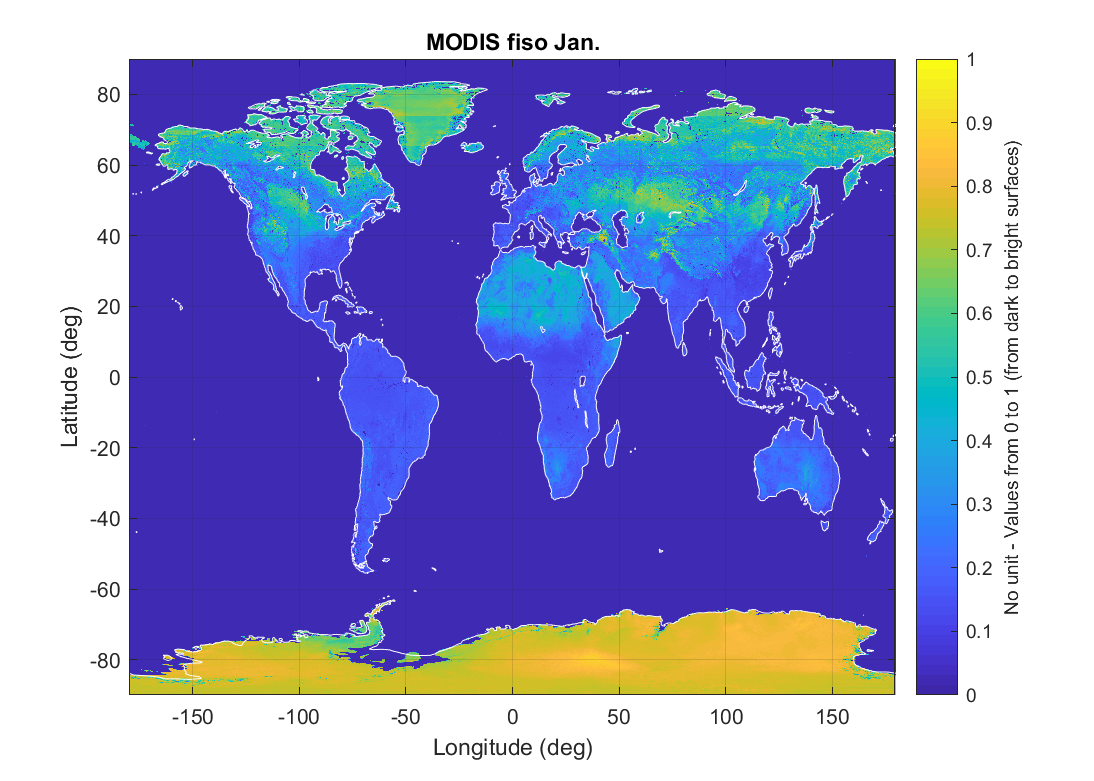MODIS albedo
MODIS components and albedo |  |
MODIS (Moderate Resolution Imaging Spectroradiometer, NASA) is an instrument aboard the Terra and Aqua satellites of the NASA. It acquires data in broadband and in several spectral bands, from which among others, three parameters (fiso, fvol, and fgeo). These parameters are components of the Bidirectional reflectance distribution function (BRDF) exploited within CAMS McClear to derive the ground albedo.
MODIS maps and webservices
| MAPS | Fiso, fgeo and fvol components:
Grid description:
Downloads per component:FISO:
FVOL:
FGEO:
NB: MSG projection illustrations have been generated in the projection after 2012-12-06 | (Click on the images to magnify) |
|---|
Other MODIS resources
| Monthly | O.I.E. - MINES ParisTech is proposing a series of 12 maps of the BRDF parameters that have been filled for gaps. Maps are also available as images (png format) for display. Color table is the same for all images for a given parameter, allowing analysis of changes throughout the year. The MODIS data sets are worldwide but restricted to land.They exhibit other irregular data gaps in time and space. |
|
|---|---|---|
| Historical daily | The MODIS data is available in a 0.05 degree Climate Modeling Grid from the year 2000 until about the last 15 days :
Find more information on the different MODIS data sets:
|
|
Publications
| Lefèvre et al. 2013 | Lefèvre M., A. Oumbe, P. Blanc, B. Espinar, B. Gschwind, Z. Qu, L. Wald, M. Schroedter-Homscheidt, C. Hoyer-Klick, A. Arola, A. Benedetti, J. W. Kaiser, and J.-J. Morcrette, 2013. "McClear: a new model estimating downwelling solar radiation at ground level in clear-sky conditions", Atmos. Meas. Tech., 6, 2403-2418, doi:10.5194/amt-6-2403-2013. | McClear |
| Blanc et al. 2014 | Blanc P., Gschwind B., Lefevre M., Wald L., 2014. "Twelve monthly maps of ground albedo parameters derived from MODIS data sets". In Proceedings of IGARSS 2014, held 13-18 July 2014, Quebec, Canada, USBKey, pp. 3270-3272. | MODIS, ground reflectance, albedo |
Content: Presentation of the monthly maps of MODIS parameters (fiso, fvol and fgeo) used to generate albedo for each instant in the year, derived from holy maps of collected MODIS maps (holes due to clouds).
| Tournadre et al. 2018 | Tournadre B., B. Gschwind, C. Thomas, L. Saboret, P. Blanc, 2018. "Characterizing the confidence in a gap-free static atlas of monthly-averaged BRDF parameters derived from MODIS MCD43C1 v5", Poster at EGU General Assembly. | MODIS, ground reflectance, albedo |










